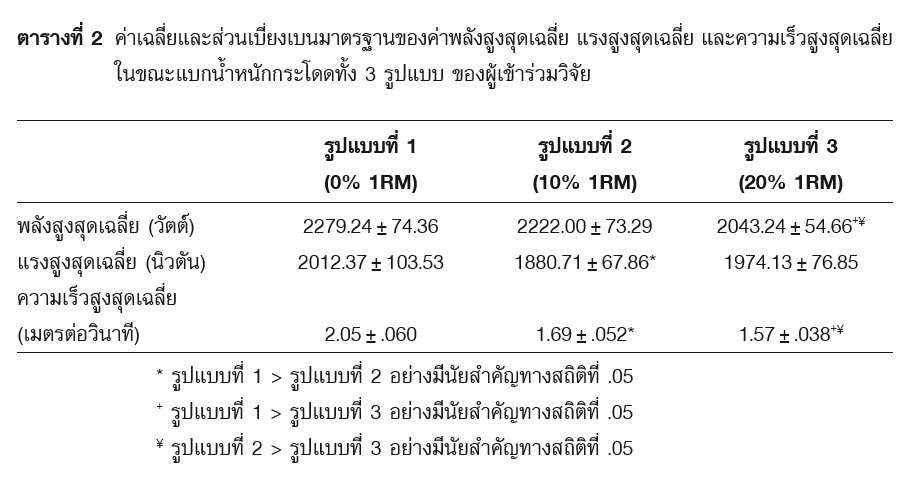ACUTE EFFECTS OF SQUAT JUMP WITH DIFFERENT WEIGHTS ON PEAK POWER IN FEMALE VOLLEYBALL PLAYERS
Main Article Content
Abstract
Purpose : The purpose of this study was to examine the acute effects of squat jump with different weights on peak power in female volleyball players.
Methods : Ten female volleyball players, aged between 18-25 years old, volunteered for this study. Each subject performed three sessions of the weighted squat jump at three different conditions (i.e. 0%, 10% and 20% of 1 RM), separated by at least 72 h. Each session consisted of repeated 20 squat jumps interspersed with 5 sec inter-repetition rest periods. The order of test was randomly assigned and counterbalanced. The peak power, force and velocity were measured using the FT-700 power system. Data were presented as mean and standard deviation (S.D.) and performance variables were analyzed using One-way ANOVA with repeated measure followed by the Bonferroni as a post-hoc test. The level of significant was set at p-value<0.05.
Results : The results showed that the average peak power of jump squat were significantly higher at the load of 0% and 10% of 1RM than that of 20% of 1 RM (P<0.05). Although the average peak force of jump squat at the load of 0% of 1RM was greater than that of 10% of 1RM (P<0.05), the average peak velocity was higher at the load of 0% of 1RM as compared to the load of 10% and 20% 1RM (P<0.05).
Conclusion : These results indicate that the unloaded jump squat is the most effective for eliciting peak power during repeated jump squat in female volleyball players.
Article Details
References
of Strength and Conditioning Research, 15(1), 92–97.
Bevan, H. R., Bunce, P. J., Owen, N. J., Bennett, M. A., Cook, C. J., Cunningham, D. J., and Kilduff, L. P. (2010). Optimal loading for the development of peak power output in professional rugby players. Journal of Strength and Conditioning Research, 24(1), 43-47.
Bompa, T., and Carrera, M. J. I. (2005). Periodization training for sports. Champaign, IL: Human Kinetics. 259.
Bompa, T. O., and Calcina, O. (1993). Periodization of strength: The new wave in strength training. Toronto : Veritas Publishing.
Cormie, P., McCaulley, G.O., and McBride, J.M. (2007). Power versus strength-power jump squat training: Influence on the loadpower relationship. Medicine and Science in Sports and Exercise, 39(6), 996-1003.
Cormie, P., Mccaulley, G.O., Tritlett, N.T., and Mcbride, J. M. (2007). Optimal loading for maximal power output during lowerbody resistance exercises. Medicine and Science in Sports and Exercise, 39(2), 340–349.
Harris, G. R., Stone, M. H., O’bryant, H. S., Proulx, C. M., and Johnson, R. L. (2000).Short-term performance effects of high power, high force, or combined weighttraining methods. Journal of Strength Conditioning Research, 14(1), 14-20.
Hoffman, J. R., Ratamess, N. A., Cooper, J. J., and Kang, J. (2005). Comparison of loaded and unloaded jump squat training on strength/power performance in college football players. Journal of Strength and Conditioning Research, 19(4), 810.
Poothong, S., and Intiraporn, C. (2017). Acute effect of complex training with different repetition and rest interval on peak power, force and velocity during jump
squat. Journal of Sports Science and Health, 18 (3), 63-72.
Purkhris, E., Krustrup, P., and Mohr, M. (2016). High-intensity training improves exercise performance in elite women volleyball players during a competitive season. Journal of Strength and Conditioning Research, 30(11), 3066-3072.
Sheppard, J.M., Dingley, A.A., Janssen, I., Spratford, W., Chapman, D.W., and Newton, R.U. (2011). The effect of assisted jumping on vertical jump height in high-performance volleyball players. Journal of Science and Medicine in Sport, 14(1), 85-89.
O'Bryant, H.S., McCoy, L., Coglianese, R., Lehmkuhl, M., and Schilling, B. (2003). Power and maximum strength relationships during performance of
dynamic and static weighted jumps.Journal of Strength and Conditioning Research, 17(1), 140–147.
Thomas, G. A., Kraemer, W. J., Spiering, B. A., and Volek, J. S. (2007). Maximal power at different percentages of one repetition maximum: influence of resistance and gender. Journal of Strength and Conditioning Research, 21(2), 336.
Wagner, H., Tilp, M., Duvillard, S. V., and Mueller, E. (2009). Kinematic analysis of volleyball spike jump. International Journal of Sports Medicine, 30(10), 760.


